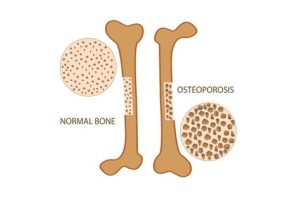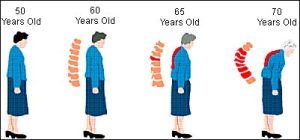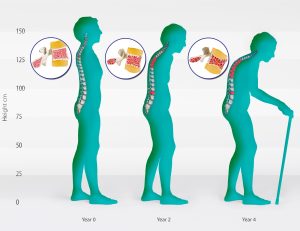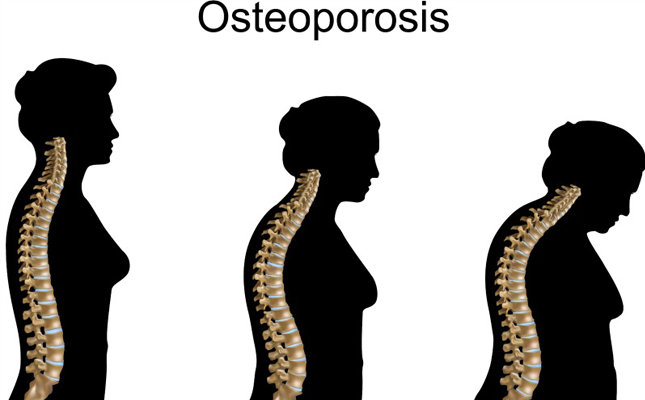We all know that women are strong and resilient, but did you know that they’re also more prone to developing a medical condition known as osteoporosis?
In layman’s terms, osteoporosis is a disease that causes bones to become weak and brittle.
According to physicians, the human bones consist of living tissues that constantly undergo a cycle of breaking down and rebuilding. When we are young, our body can generate new bone tissues more quickly than it loses old bone tissue.
The strength of your nails can indicate your bone health
However, orthopedic surgeons say, this process becomes slower as we get older. With time, the breakdown of old bone tissue may outpace its formation and this can lead to our bones becoming more porous and fragile.
According to the International Osteoporosis Foundation, one in three women who are over 50 will suffer a broken bone due to osteoporosis. And once an osteoporosis fracture has occurred, the risk of future fractures at least doubles.
Have you been experiencing severe pain in your bones and joints? If so, ensure to read this article to the end. You will learn a lot.
Risk factors for osteoporosis

Menopause: The decrease in estrogen levels during menopause is one of the strongest risk factors for developing osteoporosis.
Poor nutrition: Calcium helps bones stay strong and healthy, while Vitamin D helps calcium to get absorbed into the bone. Sadly, most women lack these nutrients because they don’t consume nutritional diet on a regular basis.
According to orthopedists, women are more prone to developing osteoporosis
Gender: This condition tends to be common in women because their bones are naturally thinner and weaker.
Age: The risk of developing osteoporosis increases as a person gets older. This is due to a natural decrease in bone mass and changes in hormones like oestrogen and testosterone that protect our bones.
Body size: Smaller and thinner women are usually susceptible to this condition because they tend to have lower bone mass. Also, oestrogen is essential for maintaining bone density, and women with lower body fat may have lower levels of oestrogen, thereby increasing their risk of bone loss and osteoporosis.
Family history: If a family member has osteoporosis, then it is possible that the woman would inherit those specific genetic factors that influence bone density, bone quality, and the rate of bone loss.
Unhealthy habits: Smoking and excessive alcohol consumption make it harder for your body to absorb calcium from food sources, and they can also reduce your bone density and increase your risk of fracture.
Also, staying physically active helps build strong bones. So, inadequate exercise or too little physical activity can lead to weaker bones in the long run.
Symptoms of osteoporosis

Osteoporosis isn’t something you can easily spot from the outside because it mostly involves a slow loss of bone over time. There are no typical symptoms in the early stages, but once the bones have been weakened, you might likely experience any of the following symptoms:
Fractures: Bones weakened by osteoporosis are much more prone to fractures, especially in the hip and spine. Such fractures can cause significant discomfort as the compressed vertebrae might press on nerves extending from the spinal cord. The pain experienced can vary from mild tenderness to severe, incapacitating pain.
Smoking, excessive alcohol consumption make it harder for your body to absorb calcium for bone health
Pain and stiffness: Osteoporosis can cause pain in the lower back, hips, and fingers, as well as increase stiffness in the joints. These symptoms can also be linked to other conditions, such as arthritis. Therefore, always consult your doctor for proper diagnosis.
Height loss: One of the most noticeable symptoms of osteoporosis is the loss of height, which is caused by compression fractures on the vertebra. This can also lead to a slight curving of the upper back, a condition known as kyphosis.
Fragile and brittle fingernails: The strength of your nails can indicate your bone health. If you notice that they are becoming weaker, then consult a doctor. Weaker grip strength can also be linked to low bone mineral density.
Treatment recommendations for osteoporosis

Exercise regularly: Did you ever think that a few sit-ups could reduce your risk of osteoporosis? Turns out, exercise isn’t just for abs and biceps—it’s also a great way to manage and prevent osteoporosis in women.
So, what kind of exercises should you be doing? Try activities like walking, jogging, stair climbing, dancing, or tennis to keep your bones strong.
Also, exercises that maintain balance can help reduce the risk of falls and fractures associated with osteoporosis. Start with simple activities such as standing on one leg for 10 seconds or performing simple yoga exercises. If you start exercising early, you can keep osteoporosis at bay.
Say no to junk food: When it comes to keeping your bones healthy and strong, certain dietary considerations need to be taken into account. First and foremost, avoid junk foods. And if you must eat them, let it be once in a while and in very small quantity.

Instead, feed on high-calcium dairy products like milk, cheese, and yoghurt, which are great sources of calcium. Vitamin D is found in oily fish like salmon, tuna and mackerel, as well as fortified foods like margarine and breakfast cereals.
You also need proteins to ensure the body absorbs the full amount of minerals that are essential for bone health. So, go ahead and enjoy plenty of lean meats like chicken or turkey.
Leafy greens like spinach are high in calcium, while other colourful fruits and veggies provide a boost of vital nutrients.
Conclusion
Are you worried about developing osteoporosis? Don’t be! From what you eat, to how much you exercise, and even the medications you take, you can reduce your risk and keep your bones strong.
So, ladies, don’t wait till your waist starts aching before practising the tips mentioned in this article. The reason is that prevention is always cheaper and better than cure.


